Cultural Intelligence and Capability: A Workplace Analysis Report
VerifiedAdded on 2020/04/29
|12
|2740
|88
Report
AI Summary
This report delves into the concepts of cultural intelligence and cultural capability, exploring their significance in fostering a safe and inclusive workplace environment. The analysis centers on a case study derived from the TV program "Fawlty Towers," where communication breakdowns due to language differences between a manager and a waiter highlight the challenges of cross-cultural interactions. The report defines key terms such as cultural intelligence, safe space, and cultural capabilities, and examines how these concepts relate to the observed scenarios. The analysis reveals the impact of cultural misunderstandings, the lack of cultural self-awareness, and the resulting communication barriers. It underscores the importance of patience, respect, and adaptability in bridging cultural divides. Recommendations include promoting compromise, fostering interest in other cultures, and ensuring clear communication to mitigate potential conflicts. The report concludes by emphasizing the critical role of cultural intelligence in creating a harmonious and productive workplace, and the need for individuals to develop these skills to navigate diverse cultural settings effectively.
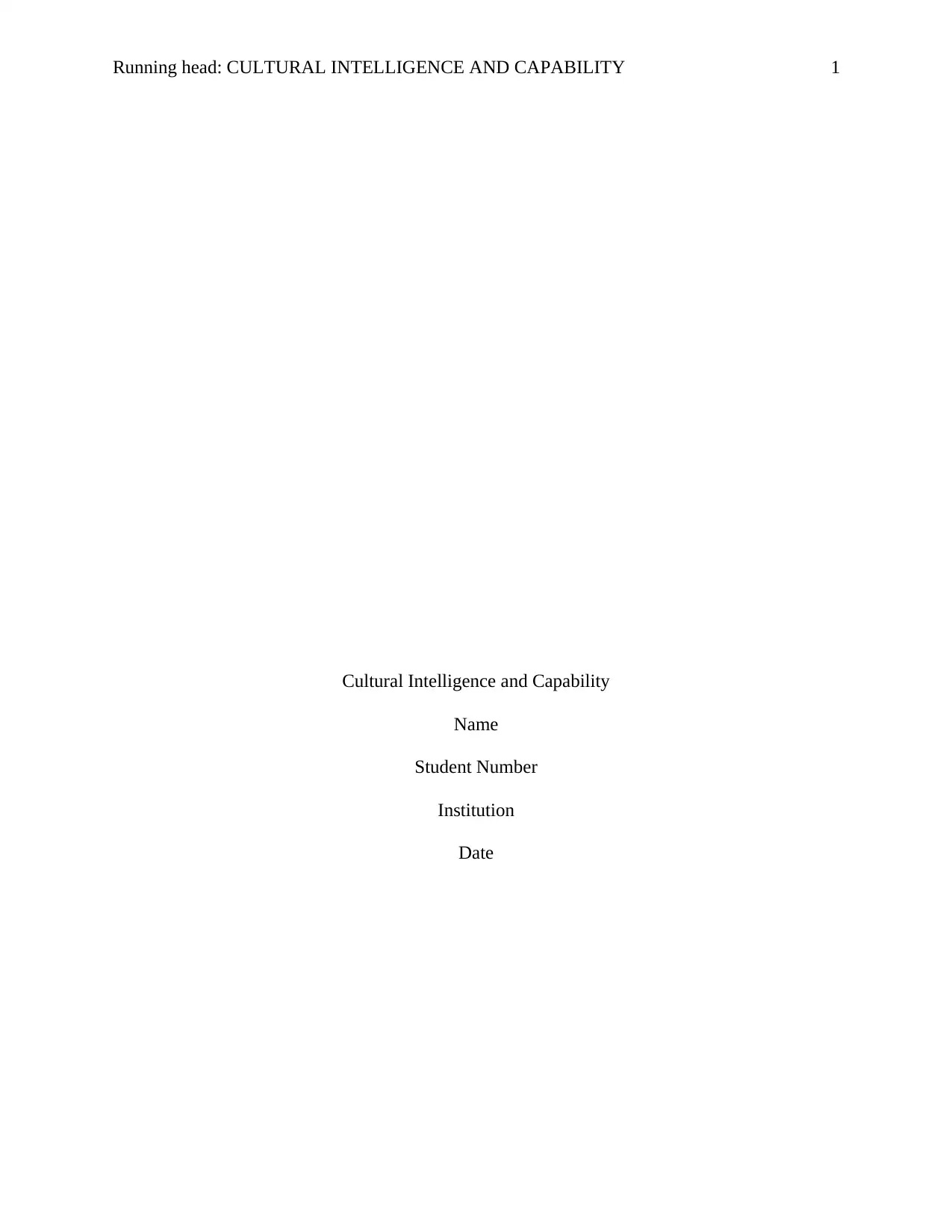
Running head: CULTURAL INTELLIGENCE AND CAPABILITY 1
Cultural Intelligence and Capability
Name
Student Number
Institution
Date
Cultural Intelligence and Capability
Name
Student Number
Institution
Date
Paraphrase This Document
Need a fresh take? Get an instant paraphrase of this document with our AI Paraphraser
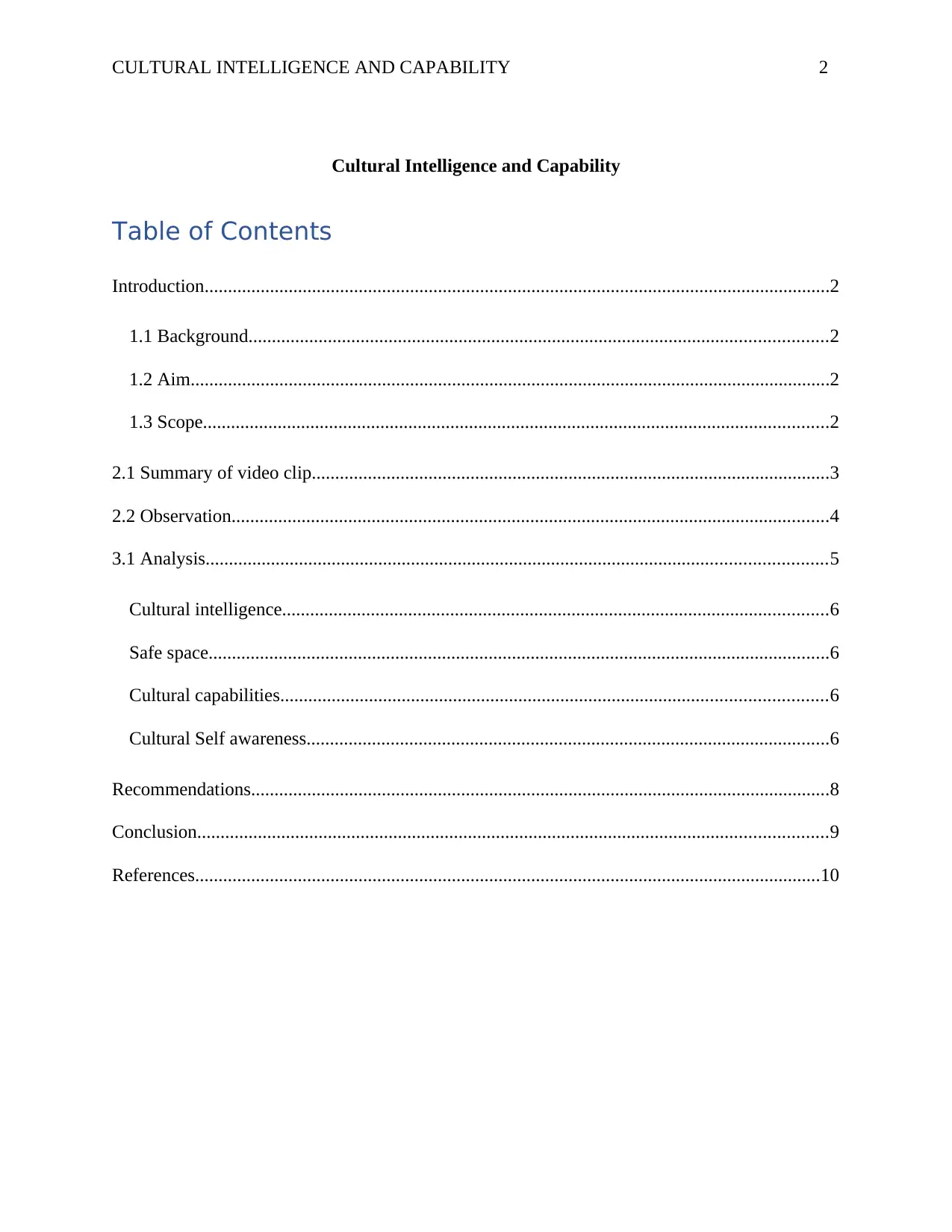
CULTURAL INTELLIGENCE AND CAPABILITY 2
Cultural Intelligence and Capability
Table of Contents
Introduction......................................................................................................................................2
1.1 Background............................................................................................................................2
1.2 Aim.........................................................................................................................................2
1.3 Scope......................................................................................................................................2
2.1 Summary of video clip...............................................................................................................3
2.2 Observation................................................................................................................................4
3.1 Analysis.....................................................................................................................................5
Cultural intelligence.....................................................................................................................6
Safe space.....................................................................................................................................6
Cultural capabilities.....................................................................................................................6
Cultural Self awareness................................................................................................................6
Recommendations............................................................................................................................8
Conclusion.......................................................................................................................................9
References......................................................................................................................................10
Cultural Intelligence and Capability
Table of Contents
Introduction......................................................................................................................................2
1.1 Background............................................................................................................................2
1.2 Aim.........................................................................................................................................2
1.3 Scope......................................................................................................................................2
2.1 Summary of video clip...............................................................................................................3
2.2 Observation................................................................................................................................4
3.1 Analysis.....................................................................................................................................5
Cultural intelligence.....................................................................................................................6
Safe space.....................................................................................................................................6
Cultural capabilities.....................................................................................................................6
Cultural Self awareness................................................................................................................6
Recommendations............................................................................................................................8
Conclusion.......................................................................................................................................9
References......................................................................................................................................10
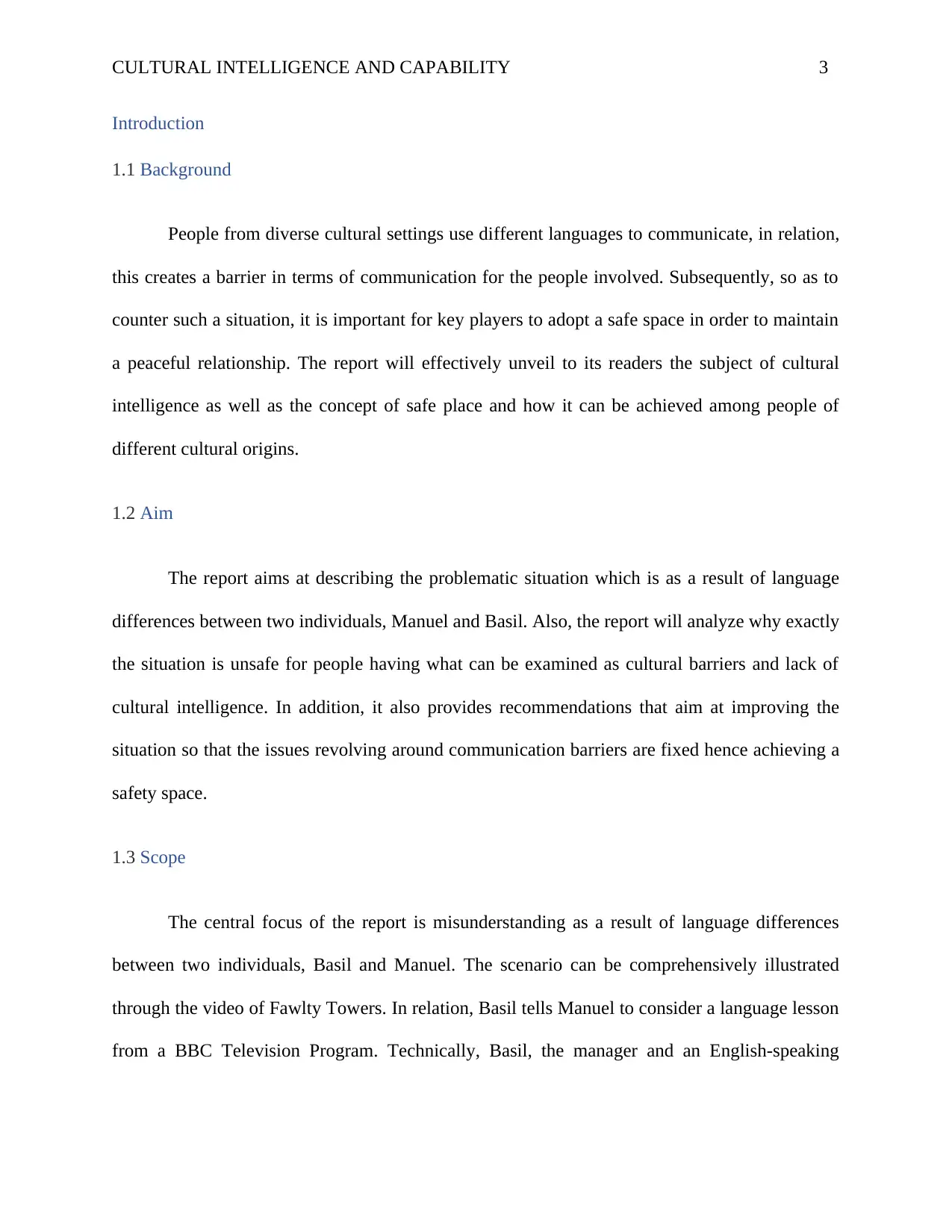
CULTURAL INTELLIGENCE AND CAPABILITY 3
Introduction
1.1 Background
People from diverse cultural settings use different languages to communicate, in relation,
this creates a barrier in terms of communication for the people involved. Subsequently, so as to
counter such a situation, it is important for key players to adopt a safe space in order to maintain
a peaceful relationship. The report will effectively unveil to its readers the subject of cultural
intelligence as well as the concept of safe place and how it can be achieved among people of
different cultural origins.
1.2 Aim
The report aims at describing the problematic situation which is as a result of language
differences between two individuals, Manuel and Basil. Also, the report will analyze why exactly
the situation is unsafe for people having what can be examined as cultural barriers and lack of
cultural intelligence. In addition, it also provides recommendations that aim at improving the
situation so that the issues revolving around communication barriers are fixed hence achieving a
safety space.
1.3 Scope
The central focus of the report is misunderstanding as a result of language differences
between two individuals, Basil and Manuel. The scenario can be comprehensively illustrated
through the video of Fawlty Towers. In relation, Basil tells Manuel to consider a language lesson
from a BBC Television Program. Technically, Basil, the manager and an English-speaking
Introduction
1.1 Background
People from diverse cultural settings use different languages to communicate, in relation,
this creates a barrier in terms of communication for the people involved. Subsequently, so as to
counter such a situation, it is important for key players to adopt a safe space in order to maintain
a peaceful relationship. The report will effectively unveil to its readers the subject of cultural
intelligence as well as the concept of safe place and how it can be achieved among people of
different cultural origins.
1.2 Aim
The report aims at describing the problematic situation which is as a result of language
differences between two individuals, Manuel and Basil. Also, the report will analyze why exactly
the situation is unsafe for people having what can be examined as cultural barriers and lack of
cultural intelligence. In addition, it also provides recommendations that aim at improving the
situation so that the issues revolving around communication barriers are fixed hence achieving a
safety space.
1.3 Scope
The central focus of the report is misunderstanding as a result of language differences
between two individuals, Basil and Manuel. The scenario can be comprehensively illustrated
through the video of Fawlty Towers. In relation, Basil tells Manuel to consider a language lesson
from a BBC Television Program. Technically, Basil, the manager and an English-speaking
⊘ This is a preview!⊘
Do you want full access?
Subscribe today to unlock all pages.

Trusted by 1+ million students worldwide
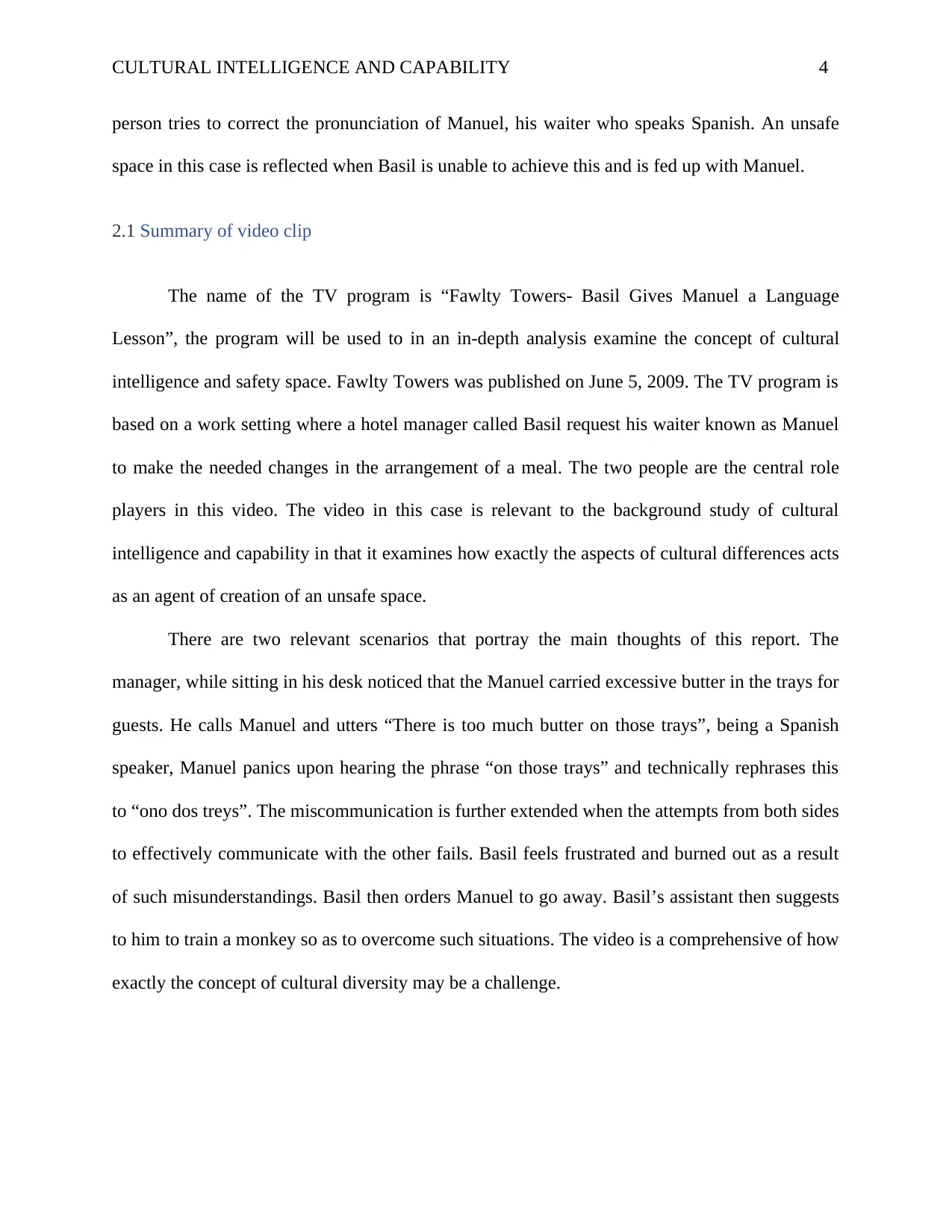
CULTURAL INTELLIGENCE AND CAPABILITY 4
person tries to correct the pronunciation of Manuel, his waiter who speaks Spanish. An unsafe
space in this case is reflected when Basil is unable to achieve this and is fed up with Manuel.
2.1 Summary of video clip
The name of the TV program is “Fawlty Towers- Basil Gives Manuel a Language
Lesson”, the program will be used to in an in-depth analysis examine the concept of cultural
intelligence and safety space. Fawlty Towers was published on June 5, 2009. The TV program is
based on a work setting where a hotel manager called Basil request his waiter known as Manuel
to make the needed changes in the arrangement of a meal. The two people are the central role
players in this video. The video in this case is relevant to the background study of cultural
intelligence and capability in that it examines how exactly the aspects of cultural differences acts
as an agent of creation of an unsafe space.
There are two relevant scenarios that portray the main thoughts of this report. The
manager, while sitting in his desk noticed that the Manuel carried excessive butter in the trays for
guests. He calls Manuel and utters “There is too much butter on those trays”, being a Spanish
speaker, Manuel panics upon hearing the phrase “on those trays” and technically rephrases this
to “ono dos treys”. The miscommunication is further extended when the attempts from both sides
to effectively communicate with the other fails. Basil feels frustrated and burned out as a result
of such misunderstandings. Basil then orders Manuel to go away. Basil’s assistant then suggests
to him to train a monkey so as to overcome such situations. The video is a comprehensive of how
exactly the concept of cultural diversity may be a challenge.
person tries to correct the pronunciation of Manuel, his waiter who speaks Spanish. An unsafe
space in this case is reflected when Basil is unable to achieve this and is fed up with Manuel.
2.1 Summary of video clip
The name of the TV program is “Fawlty Towers- Basil Gives Manuel a Language
Lesson”, the program will be used to in an in-depth analysis examine the concept of cultural
intelligence and safety space. Fawlty Towers was published on June 5, 2009. The TV program is
based on a work setting where a hotel manager called Basil request his waiter known as Manuel
to make the needed changes in the arrangement of a meal. The two people are the central role
players in this video. The video in this case is relevant to the background study of cultural
intelligence and capability in that it examines how exactly the aspects of cultural differences acts
as an agent of creation of an unsafe space.
There are two relevant scenarios that portray the main thoughts of this report. The
manager, while sitting in his desk noticed that the Manuel carried excessive butter in the trays for
guests. He calls Manuel and utters “There is too much butter on those trays”, being a Spanish
speaker, Manuel panics upon hearing the phrase “on those trays” and technically rephrases this
to “ono dos treys”. The miscommunication is further extended when the attempts from both sides
to effectively communicate with the other fails. Basil feels frustrated and burned out as a result
of such misunderstandings. Basil then orders Manuel to go away. Basil’s assistant then suggests
to him to train a monkey so as to overcome such situations. The video is a comprehensive of how
exactly the concept of cultural diversity may be a challenge.
Paraphrase This Document
Need a fresh take? Get an instant paraphrase of this document with our AI Paraphraser
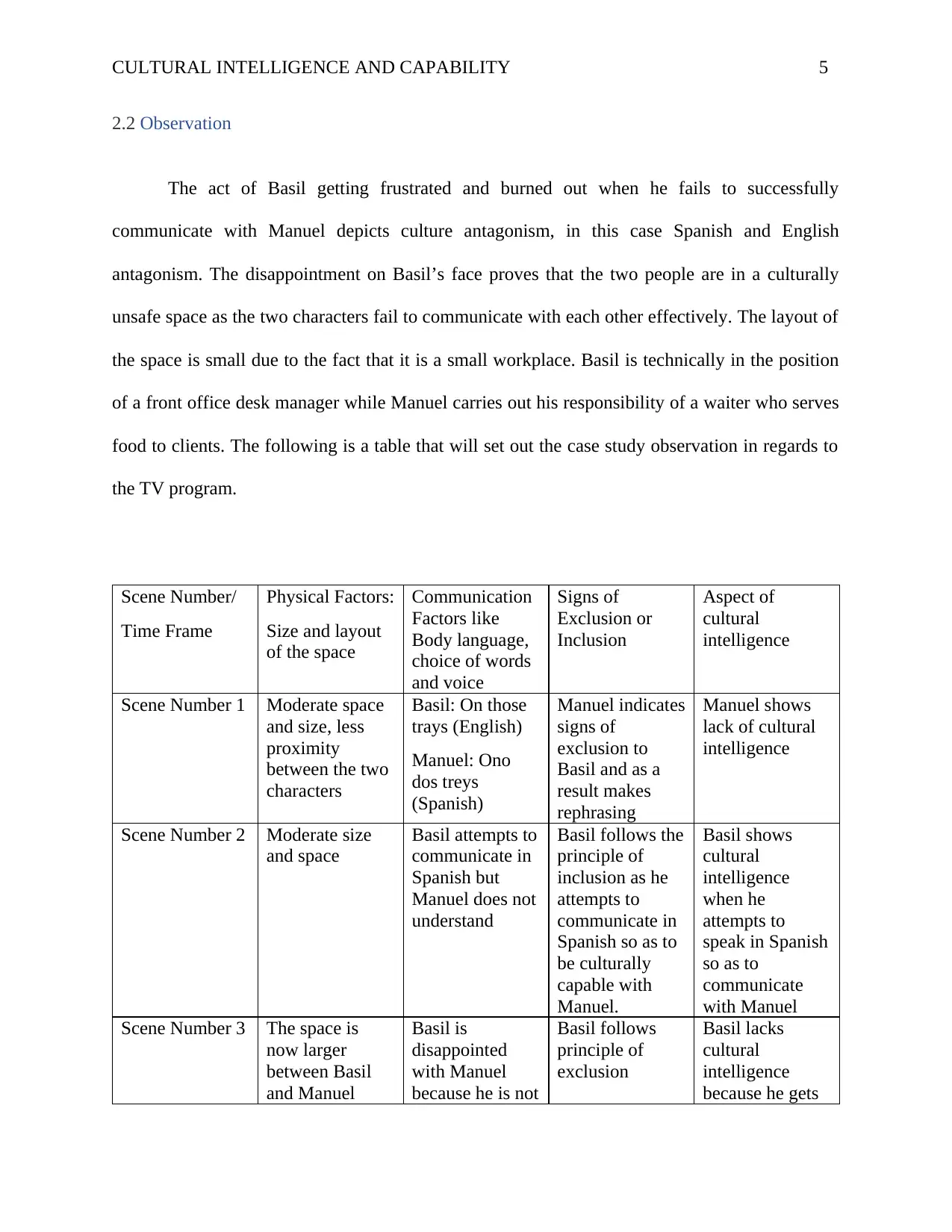
CULTURAL INTELLIGENCE AND CAPABILITY 5
2.2 Observation
The act of Basil getting frustrated and burned out when he fails to successfully
communicate with Manuel depicts culture antagonism, in this case Spanish and English
antagonism. The disappointment on Basil’s face proves that the two people are in a culturally
unsafe space as the two characters fail to communicate with each other effectively. The layout of
the space is small due to the fact that it is a small workplace. Basil is technically in the position
of a front office desk manager while Manuel carries out his responsibility of a waiter who serves
food to clients. The following is a table that will set out the case study observation in regards to
the TV program.
Scene Number/
Time Frame
Physical Factors:
Size and layout
of the space
Communication
Factors like
Body language,
choice of words
and voice
Signs of
Exclusion or
Inclusion
Aspect of
cultural
intelligence
Scene Number 1 Moderate space
and size, less
proximity
between the two
characters
Basil: On those
trays (English)
Manuel: Ono
dos treys
(Spanish)
Manuel indicates
signs of
exclusion to
Basil and as a
result makes
rephrasing
Manuel shows
lack of cultural
intelligence
Scene Number 2 Moderate size
and space
Basil attempts to
communicate in
Spanish but
Manuel does not
understand
Basil follows the
principle of
inclusion as he
attempts to
communicate in
Spanish so as to
be culturally
capable with
Manuel.
Basil shows
cultural
intelligence
when he
attempts to
speak in Spanish
so as to
communicate
with Manuel
Scene Number 3 The space is
now larger
between Basil
and Manuel
Basil is
disappointed
with Manuel
because he is not
Basil follows
principle of
exclusion
Basil lacks
cultural
intelligence
because he gets
2.2 Observation
The act of Basil getting frustrated and burned out when he fails to successfully
communicate with Manuel depicts culture antagonism, in this case Spanish and English
antagonism. The disappointment on Basil’s face proves that the two people are in a culturally
unsafe space as the two characters fail to communicate with each other effectively. The layout of
the space is small due to the fact that it is a small workplace. Basil is technically in the position
of a front office desk manager while Manuel carries out his responsibility of a waiter who serves
food to clients. The following is a table that will set out the case study observation in regards to
the TV program.
Scene Number/
Time Frame
Physical Factors:
Size and layout
of the space
Communication
Factors like
Body language,
choice of words
and voice
Signs of
Exclusion or
Inclusion
Aspect of
cultural
intelligence
Scene Number 1 Moderate space
and size, less
proximity
between the two
characters
Basil: On those
trays (English)
Manuel: Ono
dos treys
(Spanish)
Manuel indicates
signs of
exclusion to
Basil and as a
result makes
rephrasing
Manuel shows
lack of cultural
intelligence
Scene Number 2 Moderate size
and space
Basil attempts to
communicate in
Spanish but
Manuel does not
understand
Basil follows the
principle of
inclusion as he
attempts to
communicate in
Spanish so as to
be culturally
capable with
Manuel.
Basil shows
cultural
intelligence
when he
attempts to
speak in Spanish
so as to
communicate
with Manuel
Scene Number 3 The space is
now larger
between Basil
and Manuel
Basil is
disappointed
with Manuel
because he is not
Basil follows
principle of
exclusion
Basil lacks
cultural
intelligence
because he gets
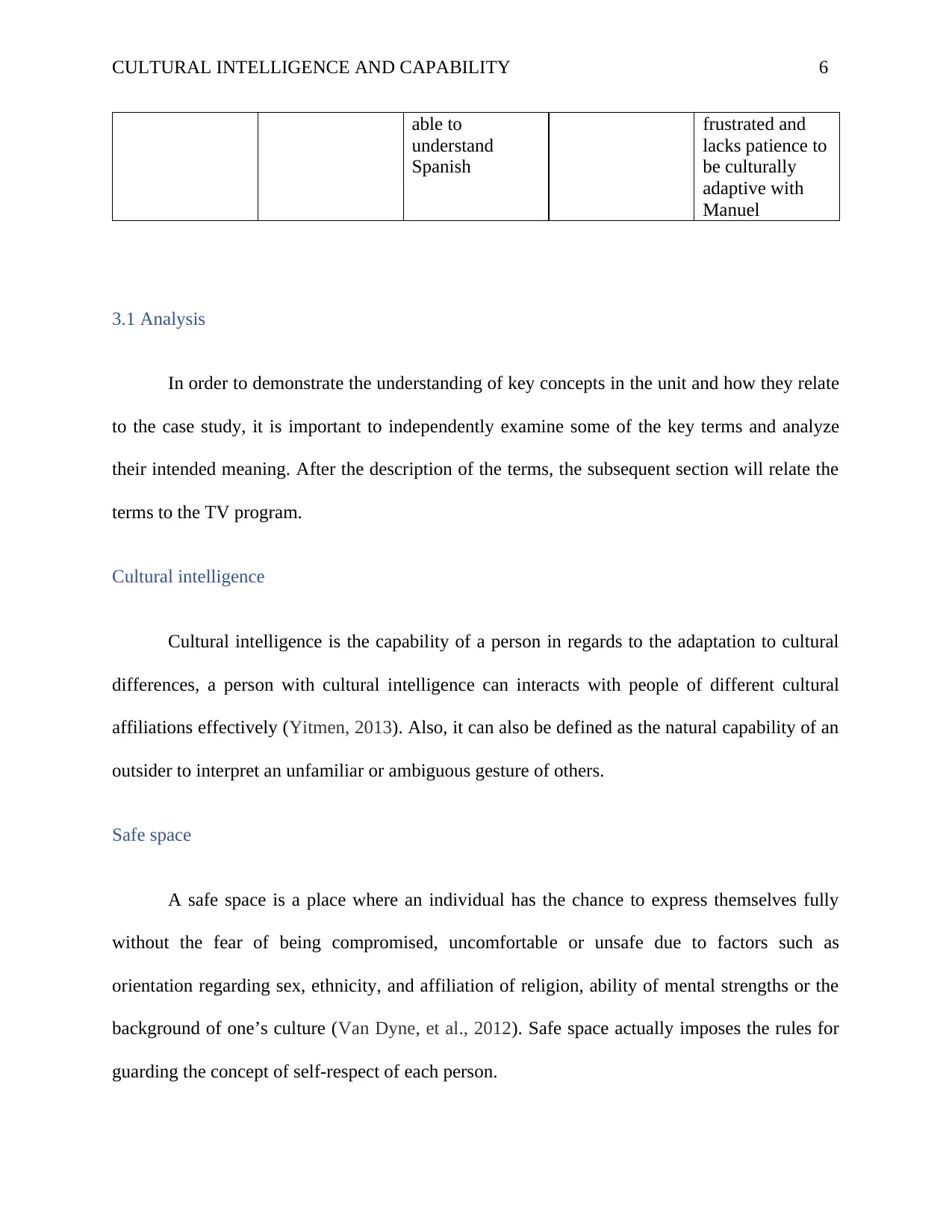
CULTURAL INTELLIGENCE AND CAPABILITY 6
able to
understand
Spanish
frustrated and
lacks patience to
be culturally
adaptive with
Manuel
3.1 Analysis
In order to demonstrate the understanding of key concepts in the unit and how they relate
to the case study, it is important to independently examine some of the key terms and analyze
their intended meaning. After the description of the terms, the subsequent section will relate the
terms to the TV program.
Cultural intelligence
Cultural intelligence is the capability of a person in regards to the adaptation to cultural
differences, a person with cultural intelligence can interacts with people of different cultural
affiliations effectively (Yitmen, 2013). Also, it can also be defined as the natural capability of an
outsider to interpret an unfamiliar or ambiguous gesture of others.
Safe space
A safe space is a place where an individual has the chance to express themselves fully
without the fear of being compromised, uncomfortable or unsafe due to factors such as
orientation regarding sex, ethnicity, and affiliation of religion, ability of mental strengths or the
background of one’s culture (Van Dyne, et al., 2012). Safe space actually imposes the rules for
guarding the concept of self-respect of each person.
able to
understand
Spanish
frustrated and
lacks patience to
be culturally
adaptive with
Manuel
3.1 Analysis
In order to demonstrate the understanding of key concepts in the unit and how they relate
to the case study, it is important to independently examine some of the key terms and analyze
their intended meaning. After the description of the terms, the subsequent section will relate the
terms to the TV program.
Cultural intelligence
Cultural intelligence is the capability of a person in regards to the adaptation to cultural
differences, a person with cultural intelligence can interacts with people of different cultural
affiliations effectively (Yitmen, 2013). Also, it can also be defined as the natural capability of an
outsider to interpret an unfamiliar or ambiguous gesture of others.
Safe space
A safe space is a place where an individual has the chance to express themselves fully
without the fear of being compromised, uncomfortable or unsafe due to factors such as
orientation regarding sex, ethnicity, and affiliation of religion, ability of mental strengths or the
background of one’s culture (Van Dyne, et al., 2012). Safe space actually imposes the rules for
guarding the concept of self-respect of each person.
⊘ This is a preview!⊘
Do you want full access?
Subscribe today to unlock all pages.

Trusted by 1+ million students worldwide
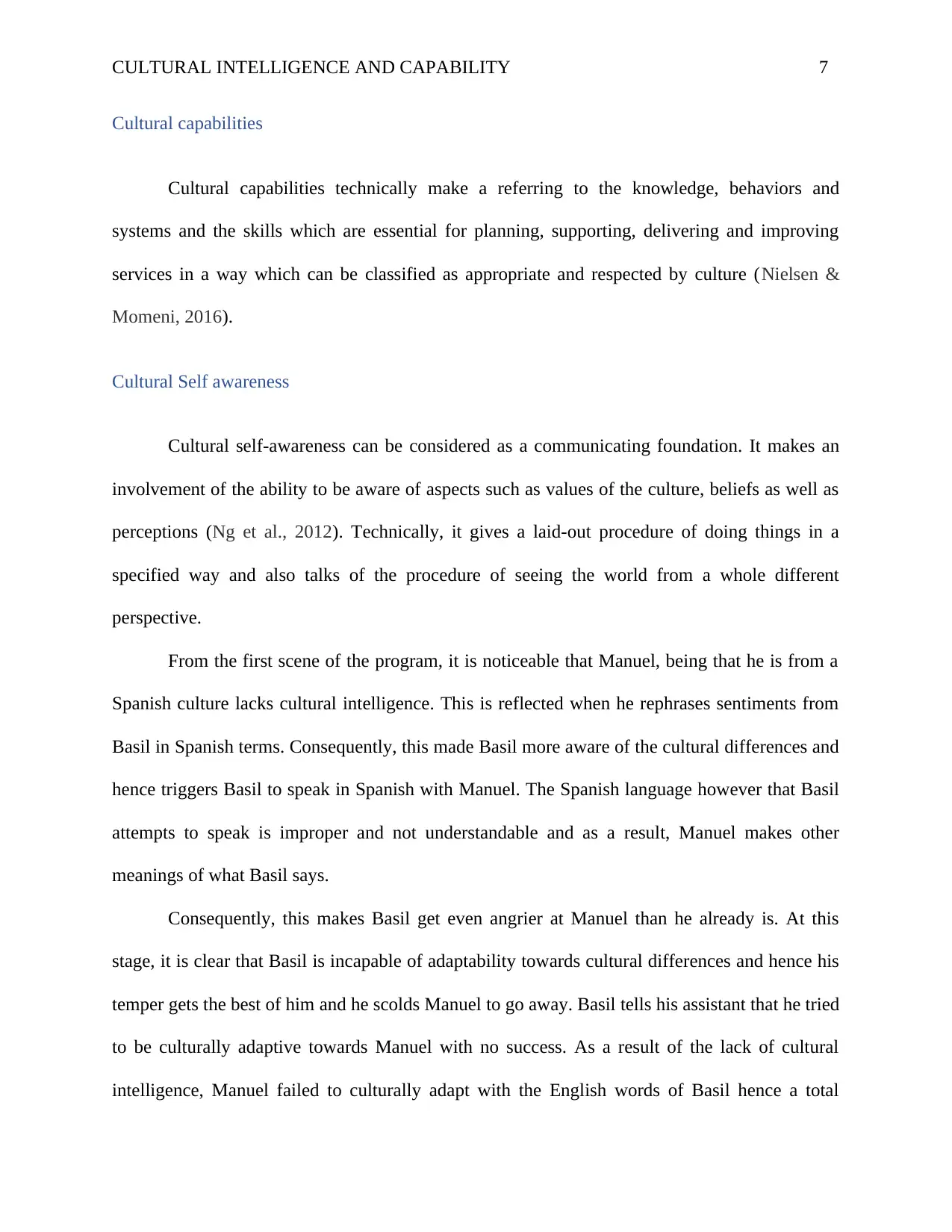
CULTURAL INTELLIGENCE AND CAPABILITY 7
Cultural capabilities
Cultural capabilities technically make a referring to the knowledge, behaviors and
systems and the skills which are essential for planning, supporting, delivering and improving
services in a way which can be classified as appropriate and respected by culture (Nielsen &
Momeni, 2016).
Cultural Self awareness
Cultural self-awareness can be considered as a communicating foundation. It makes an
involvement of the ability to be aware of aspects such as values of the culture, beliefs as well as
perceptions (Ng et al., 2012). Technically, it gives a laid-out procedure of doing things in a
specified way and also talks of the procedure of seeing the world from a whole different
perspective.
From the first scene of the program, it is noticeable that Manuel, being that he is from a
Spanish culture lacks cultural intelligence. This is reflected when he rephrases sentiments from
Basil in Spanish terms. Consequently, this made Basil more aware of the cultural differences and
hence triggers Basil to speak in Spanish with Manuel. The Spanish language however that Basil
attempts to speak is improper and not understandable and as a result, Manuel makes other
meanings of what Basil says.
Consequently, this makes Basil get even angrier at Manuel than he already is. At this
stage, it is clear that Basil is incapable of adaptability towards cultural differences and hence his
temper gets the best of him and he scolds Manuel to go away. Basil tells his assistant that he tried
to be culturally adaptive towards Manuel with no success. As a result of the lack of cultural
intelligence, Manuel failed to culturally adapt with the English words of Basil hence a total
Cultural capabilities
Cultural capabilities technically make a referring to the knowledge, behaviors and
systems and the skills which are essential for planning, supporting, delivering and improving
services in a way which can be classified as appropriate and respected by culture (Nielsen &
Momeni, 2016).
Cultural Self awareness
Cultural self-awareness can be considered as a communicating foundation. It makes an
involvement of the ability to be aware of aspects such as values of the culture, beliefs as well as
perceptions (Ng et al., 2012). Technically, it gives a laid-out procedure of doing things in a
specified way and also talks of the procedure of seeing the world from a whole different
perspective.
From the first scene of the program, it is noticeable that Manuel, being that he is from a
Spanish culture lacks cultural intelligence. This is reflected when he rephrases sentiments from
Basil in Spanish terms. Consequently, this made Basil more aware of the cultural differences and
hence triggers Basil to speak in Spanish with Manuel. The Spanish language however that Basil
attempts to speak is improper and not understandable and as a result, Manuel makes other
meanings of what Basil says.
Consequently, this makes Basil get even angrier at Manuel than he already is. At this
stage, it is clear that Basil is incapable of adaptability towards cultural differences and hence his
temper gets the best of him and he scolds Manuel to go away. Basil tells his assistant that he tried
to be culturally adaptive towards Manuel with no success. As a result of the lack of cultural
intelligence, Manuel failed to culturally adapt with the English words of Basil hence a total
Paraphrase This Document
Need a fresh take? Get an instant paraphrase of this document with our AI Paraphraser
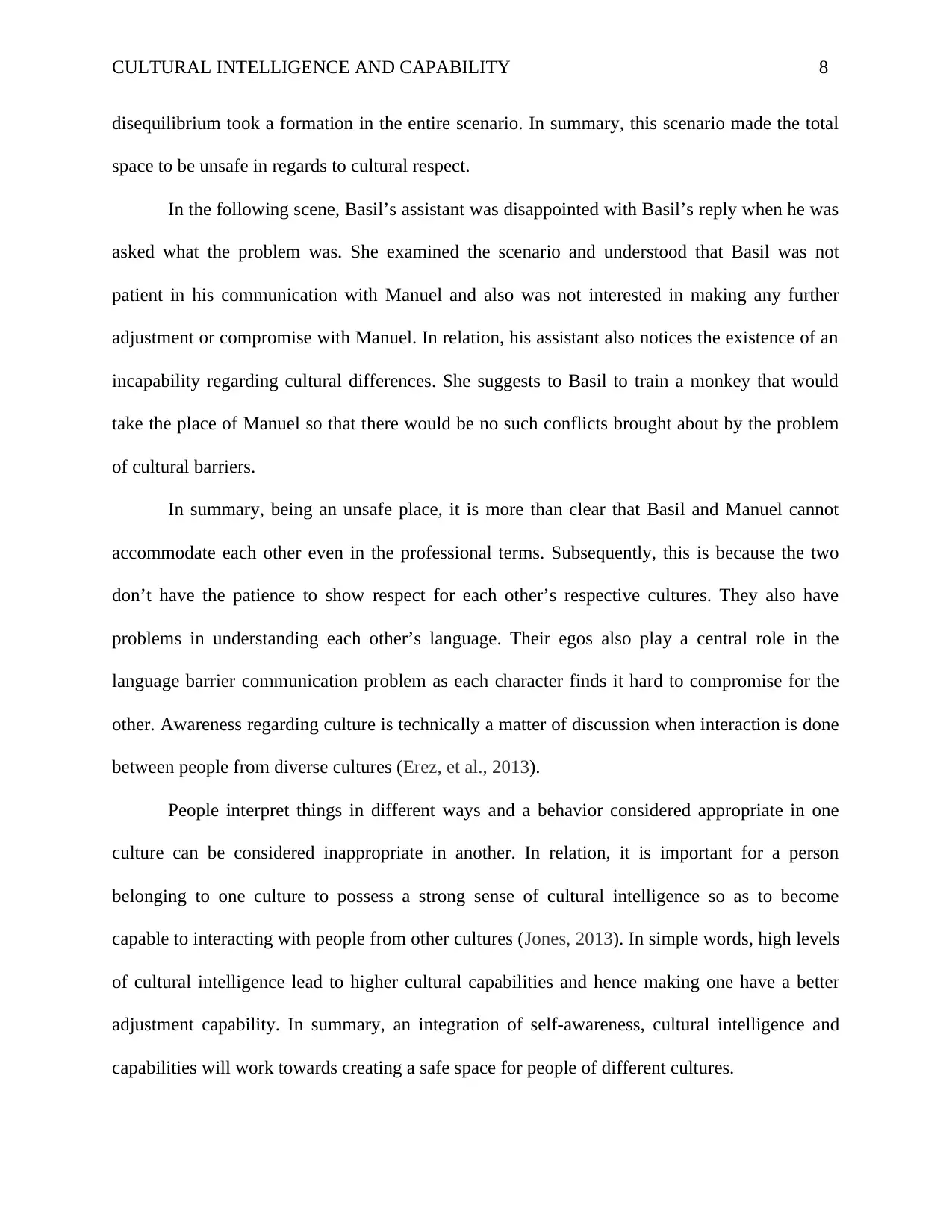
CULTURAL INTELLIGENCE AND CAPABILITY 8
disequilibrium took a formation in the entire scenario. In summary, this scenario made the total
space to be unsafe in regards to cultural respect.
In the following scene, Basil’s assistant was disappointed with Basil’s reply when he was
asked what the problem was. She examined the scenario and understood that Basil was not
patient in his communication with Manuel and also was not interested in making any further
adjustment or compromise with Manuel. In relation, his assistant also notices the existence of an
incapability regarding cultural differences. She suggests to Basil to train a monkey that would
take the place of Manuel so that there would be no such conflicts brought about by the problem
of cultural barriers.
In summary, being an unsafe place, it is more than clear that Basil and Manuel cannot
accommodate each other even in the professional terms. Subsequently, this is because the two
don’t have the patience to show respect for each other’s respective cultures. They also have
problems in understanding each other’s language. Their egos also play a central role in the
language barrier communication problem as each character finds it hard to compromise for the
other. Awareness regarding culture is technically a matter of discussion when interaction is done
between people from diverse cultures (Erez, et al., 2013).
People interpret things in different ways and a behavior considered appropriate in one
culture can be considered inappropriate in another. In relation, it is important for a person
belonging to one culture to possess a strong sense of cultural intelligence so as to become
capable to interacting with people from other cultures (Jones, 2013). In simple words, high levels
of cultural intelligence lead to higher cultural capabilities and hence making one have a better
adjustment capability. In summary, an integration of self-awareness, cultural intelligence and
capabilities will work towards creating a safe space for people of different cultures.
disequilibrium took a formation in the entire scenario. In summary, this scenario made the total
space to be unsafe in regards to cultural respect.
In the following scene, Basil’s assistant was disappointed with Basil’s reply when he was
asked what the problem was. She examined the scenario and understood that Basil was not
patient in his communication with Manuel and also was not interested in making any further
adjustment or compromise with Manuel. In relation, his assistant also notices the existence of an
incapability regarding cultural differences. She suggests to Basil to train a monkey that would
take the place of Manuel so that there would be no such conflicts brought about by the problem
of cultural barriers.
In summary, being an unsafe place, it is more than clear that Basil and Manuel cannot
accommodate each other even in the professional terms. Subsequently, this is because the two
don’t have the patience to show respect for each other’s respective cultures. They also have
problems in understanding each other’s language. Their egos also play a central role in the
language barrier communication problem as each character finds it hard to compromise for the
other. Awareness regarding culture is technically a matter of discussion when interaction is done
between people from diverse cultures (Erez, et al., 2013).
People interpret things in different ways and a behavior considered appropriate in one
culture can be considered inappropriate in another. In relation, it is important for a person
belonging to one culture to possess a strong sense of cultural intelligence so as to become
capable to interacting with people from other cultures (Jones, 2013). In simple words, high levels
of cultural intelligence lead to higher cultural capabilities and hence making one have a better
adjustment capability. In summary, an integration of self-awareness, cultural intelligence and
capabilities will work towards creating a safe space for people of different cultures.
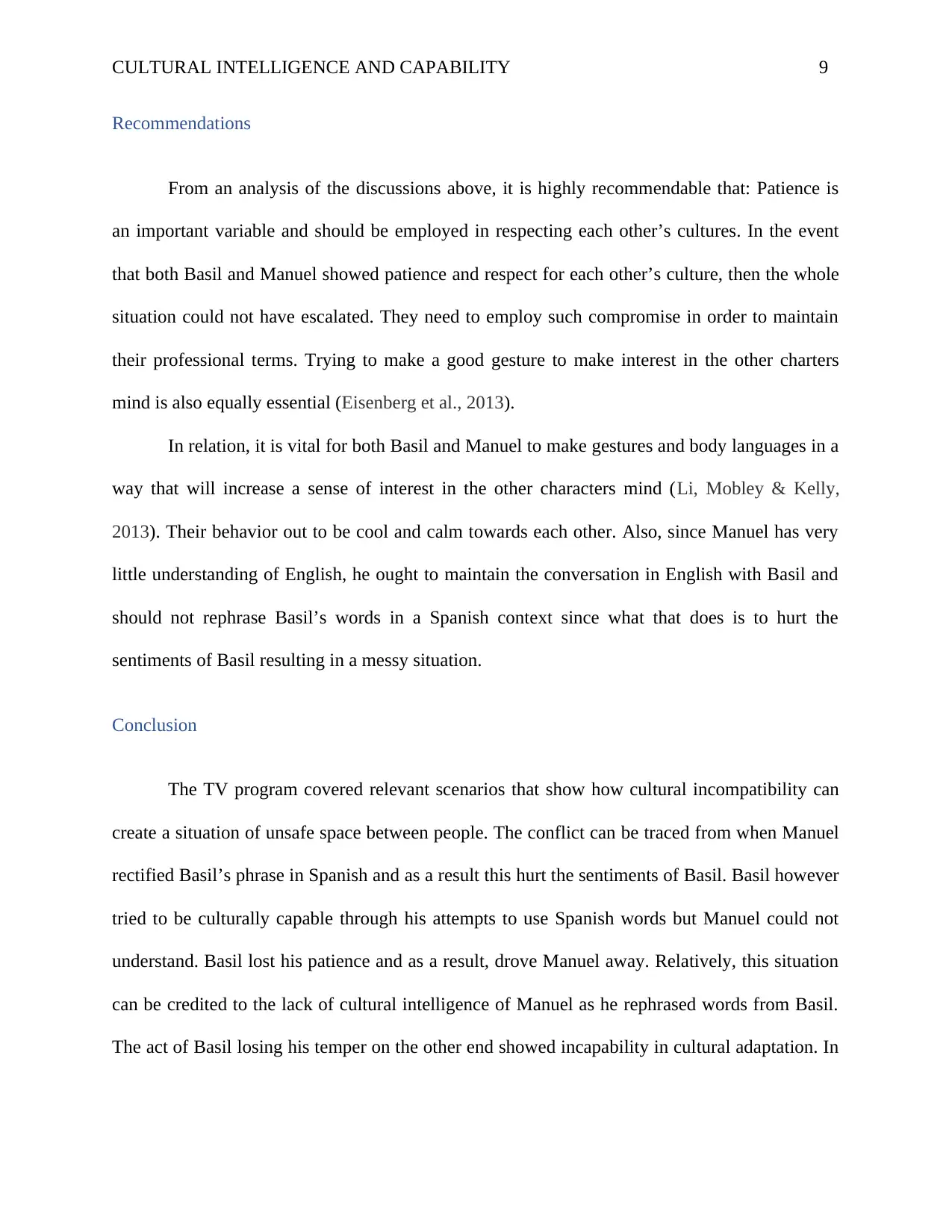
CULTURAL INTELLIGENCE AND CAPABILITY 9
Recommendations
From an analysis of the discussions above, it is highly recommendable that: Patience is
an important variable and should be employed in respecting each other’s cultures. In the event
that both Basil and Manuel showed patience and respect for each other’s culture, then the whole
situation could not have escalated. They need to employ such compromise in order to maintain
their professional terms. Trying to make a good gesture to make interest in the other charters
mind is also equally essential (Eisenberg et al., 2013).
In relation, it is vital for both Basil and Manuel to make gestures and body languages in a
way that will increase a sense of interest in the other characters mind (Li, Mobley & Kelly,
2013). Their behavior out to be cool and calm towards each other. Also, since Manuel has very
little understanding of English, he ought to maintain the conversation in English with Basil and
should not rephrase Basil’s words in a Spanish context since what that does is to hurt the
sentiments of Basil resulting in a messy situation.
Conclusion
The TV program covered relevant scenarios that show how cultural incompatibility can
create a situation of unsafe space between people. The conflict can be traced from when Manuel
rectified Basil’s phrase in Spanish and as a result this hurt the sentiments of Basil. Basil however
tried to be culturally capable through his attempts to use Spanish words but Manuel could not
understand. Basil lost his patience and as a result, drove Manuel away. Relatively, this situation
can be credited to the lack of cultural intelligence of Manuel as he rephrased words from Basil.
The act of Basil losing his temper on the other end showed incapability in cultural adaptation. In
Recommendations
From an analysis of the discussions above, it is highly recommendable that: Patience is
an important variable and should be employed in respecting each other’s cultures. In the event
that both Basil and Manuel showed patience and respect for each other’s culture, then the whole
situation could not have escalated. They need to employ such compromise in order to maintain
their professional terms. Trying to make a good gesture to make interest in the other charters
mind is also equally essential (Eisenberg et al., 2013).
In relation, it is vital for both Basil and Manuel to make gestures and body languages in a
way that will increase a sense of interest in the other characters mind (Li, Mobley & Kelly,
2013). Their behavior out to be cool and calm towards each other. Also, since Manuel has very
little understanding of English, he ought to maintain the conversation in English with Basil and
should not rephrase Basil’s words in a Spanish context since what that does is to hurt the
sentiments of Basil resulting in a messy situation.
Conclusion
The TV program covered relevant scenarios that show how cultural incompatibility can
create a situation of unsafe space between people. The conflict can be traced from when Manuel
rectified Basil’s phrase in Spanish and as a result this hurt the sentiments of Basil. Basil however
tried to be culturally capable through his attempts to use Spanish words but Manuel could not
understand. Basil lost his patience and as a result, drove Manuel away. Relatively, this situation
can be credited to the lack of cultural intelligence of Manuel as he rephrased words from Basil.
The act of Basil losing his temper on the other end showed incapability in cultural adaptation. In
⊘ This is a preview!⊘
Do you want full access?
Subscribe today to unlock all pages.

Trusted by 1+ million students worldwide
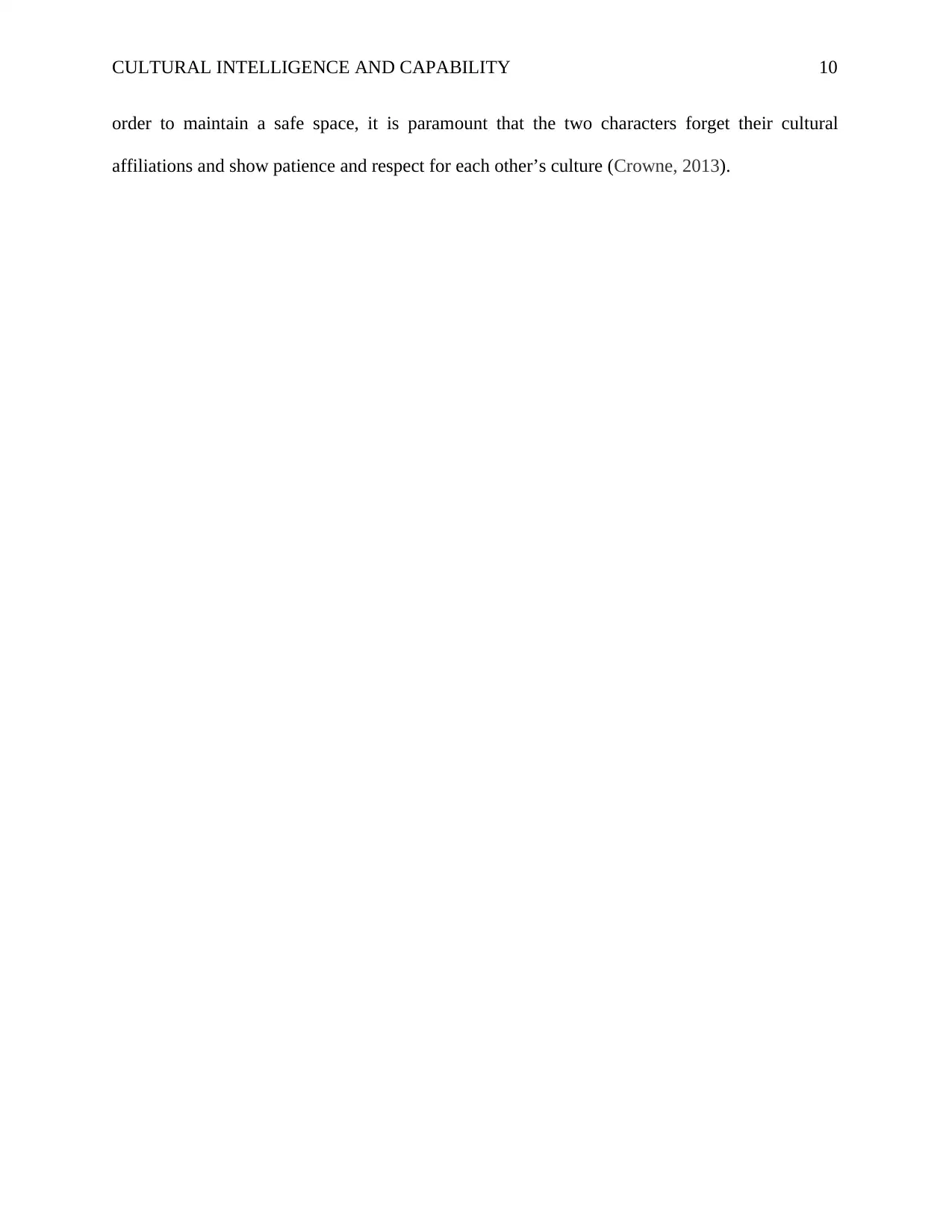
CULTURAL INTELLIGENCE AND CAPABILITY 10
order to maintain a safe space, it is paramount that the two characters forget their cultural
affiliations and show patience and respect for each other’s culture (Crowne, 2013).
order to maintain a safe space, it is paramount that the two characters forget their cultural
affiliations and show patience and respect for each other’s culture (Crowne, 2013).
Paraphrase This Document
Need a fresh take? Get an instant paraphrase of this document with our AI Paraphraser
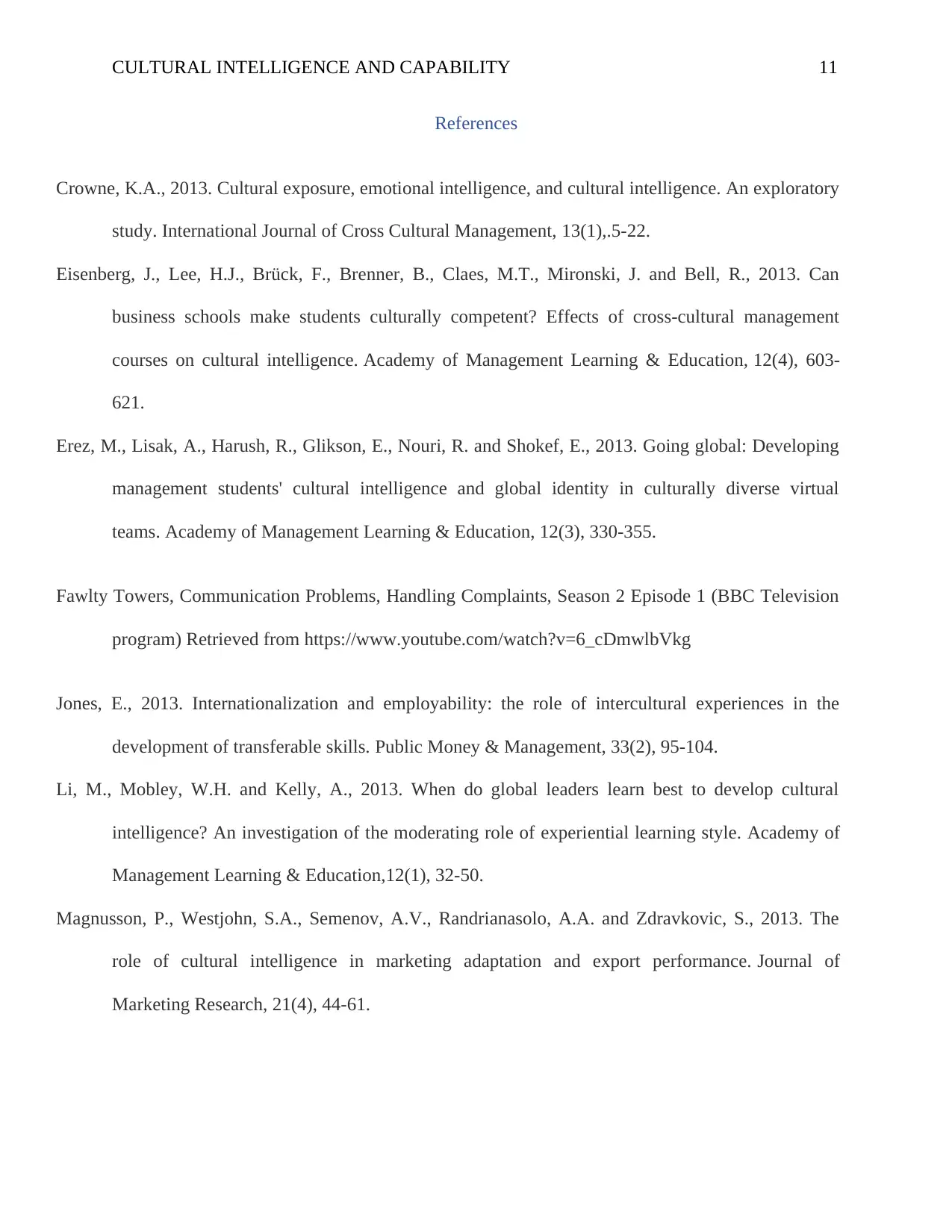
CULTURAL INTELLIGENCE AND CAPABILITY 11
References
Crowne, K.A., 2013. Cultural exposure, emotional intelligence, and cultural intelligence. An exploratory
study. International Journal of Cross Cultural Management, 13(1),.5-22.
Eisenberg, J., Lee, H.J., Brück, F., Brenner, B., Claes, M.T., Mironski, J. and Bell, R., 2013. Can
business schools make students culturally competent? Effects of cross-cultural management
courses on cultural intelligence. Academy of Management Learning & Education, 12(4), 603-
621.
Erez, M., Lisak, A., Harush, R., Glikson, E., Nouri, R. and Shokef, E., 2013. Going global: Developing
management students' cultural intelligence and global identity in culturally diverse virtual
teams. Academy of Management Learning & Education, 12(3), 330-355.
Fawlty Towers, Communication Problems, Handling Complaints, Season 2 Episode 1 (BBC Television
program) Retrieved from https://www.youtube.com/watch?v=6_cDmwlbVkg
Jones, E., 2013. Internationalization and employability: the role of intercultural experiences in the
development of transferable skills. Public Money & Management, 33(2), 95-104.
Li, M., Mobley, W.H. and Kelly, A., 2013. When do global leaders learn best to develop cultural
intelligence? An investigation of the moderating role of experiential learning style. Academy of
Management Learning & Education,12(1), 32-50.
Magnusson, P., Westjohn, S.A., Semenov, A.V., Randrianasolo, A.A. and Zdravkovic, S., 2013. The
role of cultural intelligence in marketing adaptation and export performance. Journal of
Marketing Research, 21(4), 44-61.
References
Crowne, K.A., 2013. Cultural exposure, emotional intelligence, and cultural intelligence. An exploratory
study. International Journal of Cross Cultural Management, 13(1),.5-22.
Eisenberg, J., Lee, H.J., Brück, F., Brenner, B., Claes, M.T., Mironski, J. and Bell, R., 2013. Can
business schools make students culturally competent? Effects of cross-cultural management
courses on cultural intelligence. Academy of Management Learning & Education, 12(4), 603-
621.
Erez, M., Lisak, A., Harush, R., Glikson, E., Nouri, R. and Shokef, E., 2013. Going global: Developing
management students' cultural intelligence and global identity in culturally diverse virtual
teams. Academy of Management Learning & Education, 12(3), 330-355.
Fawlty Towers, Communication Problems, Handling Complaints, Season 2 Episode 1 (BBC Television
program) Retrieved from https://www.youtube.com/watch?v=6_cDmwlbVkg
Jones, E., 2013. Internationalization and employability: the role of intercultural experiences in the
development of transferable skills. Public Money & Management, 33(2), 95-104.
Li, M., Mobley, W.H. and Kelly, A., 2013. When do global leaders learn best to develop cultural
intelligence? An investigation of the moderating role of experiential learning style. Academy of
Management Learning & Education,12(1), 32-50.
Magnusson, P., Westjohn, S.A., Semenov, A.V., Randrianasolo, A.A. and Zdravkovic, S., 2013. The
role of cultural intelligence in marketing adaptation and export performance. Journal of
Marketing Research, 21(4), 44-61.
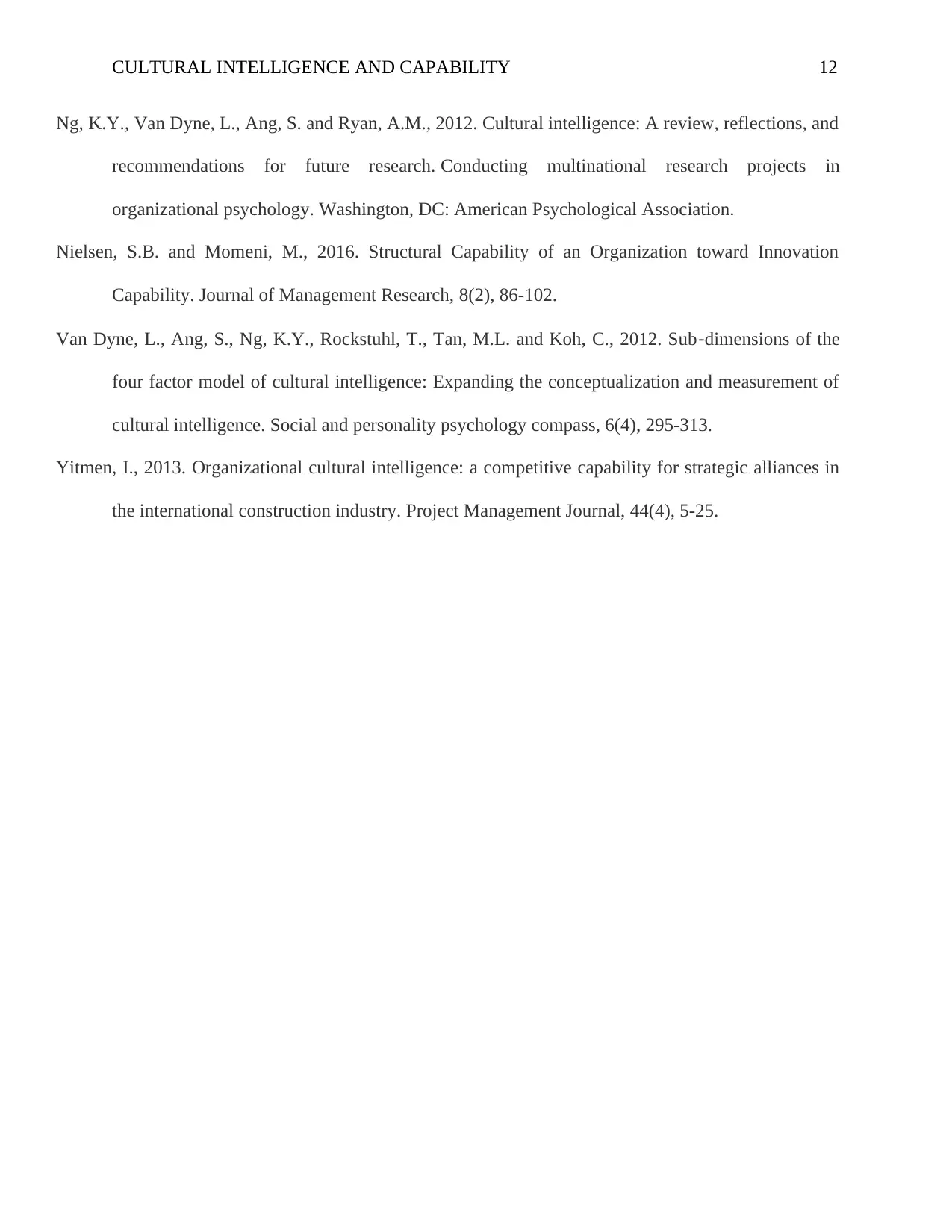
CULTURAL INTELLIGENCE AND CAPABILITY 12
Ng, K.Y., Van Dyne, L., Ang, S. and Ryan, A.M., 2012. Cultural intelligence: A review, reflections, and
recommendations for future research. Conducting multinational research projects in
organizational psychology. Washington, DC: American Psychological Association.
Nielsen, S.B. and Momeni, M., 2016. Structural Capability of an Organization toward Innovation
Capability. Journal of Management Research, 8(2), 86-102.
Van Dyne, L., Ang, S., Ng, K.Y., Rockstuhl, T., Tan, M.L. and Koh, C., 2012. Sub‐dimensions of the
four factor model of cultural intelligence: Expanding the conceptualization and measurement of
cultural intelligence. Social and personality psychology compass, 6(4), 295-313.
Yitmen, I., 2013. Organizational cultural intelligence: a competitive capability for strategic alliances in
the international construction industry. Project Management Journal, 44(4), 5-25.
Ng, K.Y., Van Dyne, L., Ang, S. and Ryan, A.M., 2012. Cultural intelligence: A review, reflections, and
recommendations for future research. Conducting multinational research projects in
organizational psychology. Washington, DC: American Psychological Association.
Nielsen, S.B. and Momeni, M., 2016. Structural Capability of an Organization toward Innovation
Capability. Journal of Management Research, 8(2), 86-102.
Van Dyne, L., Ang, S., Ng, K.Y., Rockstuhl, T., Tan, M.L. and Koh, C., 2012. Sub‐dimensions of the
four factor model of cultural intelligence: Expanding the conceptualization and measurement of
cultural intelligence. Social and personality psychology compass, 6(4), 295-313.
Yitmen, I., 2013. Organizational cultural intelligence: a competitive capability for strategic alliances in
the international construction industry. Project Management Journal, 44(4), 5-25.
⊘ This is a preview!⊘
Do you want full access?
Subscribe today to unlock all pages.

Trusted by 1+ million students worldwide
1 out of 12
Related Documents
Your All-in-One AI-Powered Toolkit for Academic Success.
+13062052269
info@desklib.com
Available 24*7 on WhatsApp / Email
![[object Object]](/_next/static/media/star-bottom.7253800d.svg)
Unlock your academic potential
Copyright © 2020–2025 A2Z Services. All Rights Reserved. Developed and managed by ZUCOL.



